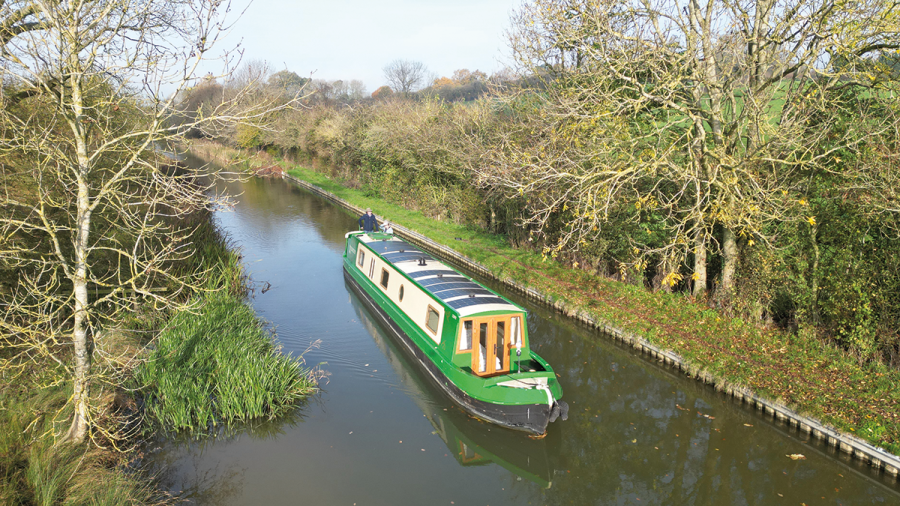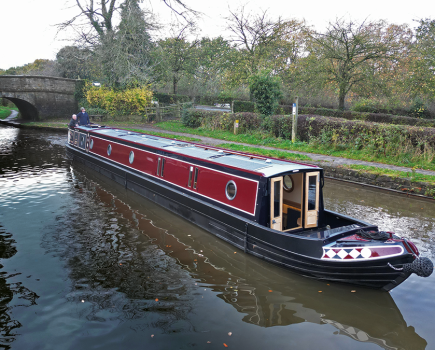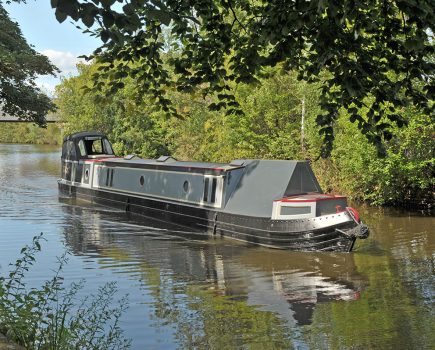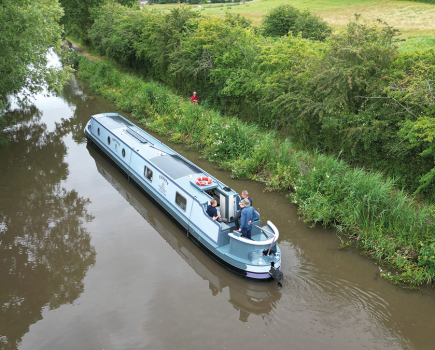This bespoke 56-footer is a bit different from the norm but works on every level.
Words by Adam Porters | Pictures by Andy Annable
Are you a brass person or a fan of chrome? It might not be as controversial a division among boaters as which sort of toilet you prefer, but it’s still something which has a big impact on your boat. Brass trim looks more traditional, while chrome or stainless steel looks more contemporary.
Unless you’re American, like Hawley Montgomery-Downs, who had this boat built. For her, chrome reminds her of nineties furniture (think chrome and smoked glass coffee tables!), while brass and gold has a more-cosy feel.
In fact, the design and colour scheme of this whole boat is very personal, as a good bespoke boat should be. And it’s not only the paint that’s green – many aspects of the boat are too. It has electric propulsion, the generator runs on HVO rather than diesel, and the stove burns wood but not coal.
Unexpected has been built by Ortomarine, who’ve gained a reputation for striving towards sustainable boating. And while it has the feel of a typical Ortomarine boat, some of Hawley’s decisions have resulted in something that’s a bit different.
EXTERIOR
Unexpected is built on a 56ft shell by Tim Tyler. That’s a couple of feet shorter than most of Ortomarine’s previous boats, because Hawley will spend a lot of her time single-handing, so wanted something that was slightly easier to handle.
The colour scheme is striking, with bright green and cream paintwork separated by a gold coachline. Hawley’s design student daughter came up with the scheme for both the exterior and inside – and even designed the artwork for the signwriting of the name. The window frames, by Caldwell’s, have gold powder coated frames to match. The mushroom vents, though, are black to fit in with the ten solar panels on the roof.
The Tim Tyler shell has an attractive curvy bow, and there’s a huge locker with a large lid in the nose. The well deck has a cross locker which give access to the bow thruster, and more lockers on both sides. The water tank is underneath.
The semi-cruiser stern has a metal dodger round the back of the deck, with built-in seating, and a broad metal top; this should require less maintenance than if it was made from wood. The dodger has a large cutout where the tiller goes, which stops the whole thing looking too heavy. The cabin sides sweep down to form the semi-cruiser part of the stern, and there are storage lockers on both sides, which are lockable. All in all, it’s an attractive boat on the water.
LAYOUT AND FITOUT
This is a reverse layout boat, but with a few tweaks. For a start, immediately inside the stern is a lobby area which Hawley calls a mud room – somewhere for taking off boots and wet coats. It’s reminiscent of a modern trad’s engine room. Steps then lead off to one side down into the boat.
The galley comes next, the position of the stairs means Hawley could have the U-shape she wanted. There’s a breakfast bar before the saloon. Next comes an off-corridor shower room (something of a rarity these days), with the cabin at the bow. This includes a secluded changing area.
The fitout is bright and contemporary. Both above and below the gunwales there’s painted vertical tongue and groove effect moisture resistant MDF, in a soft cream colour. The bulkheads are given the same treatment, to give a sense of continuity. The vertical lines make the walls look taller. The ceiling is similar but painted white. All the trim is American white oak, which provides a nice contrast.
The floor is a Luxury Vinyl Tile, but unusually the planks are laid across the boat, again to trick the eye into thinking the space is wider than it really is.
MUD ROOM
We’ll start at the stern, with the little mud room or lobby. On one side is a double electrical cupboard, containing all the boat’s electrics. The space is big enough that everything can be neatly laid out. The batteries extend from the base of the cupboard under the floor. The steps take you to the right-hand side of the boat; they’re wide and easy to use.
This design came about because of Hawley’s experience of hire boats. She didn’t like that people could see right into the boat; having the mud room there means that even with the stern doors open, people can’t see in.
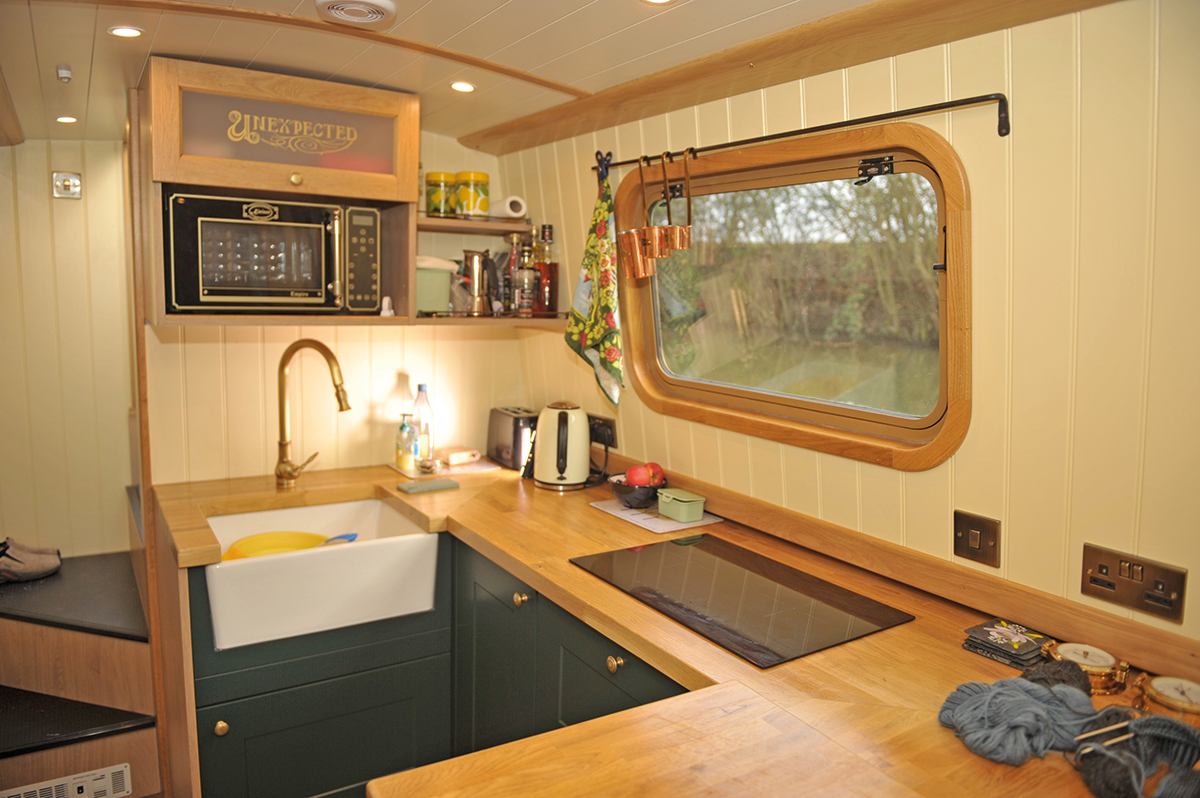
GALLEY
The main part of the galley consists of a generous U-shape. On the opposite side of the boat is a single unit. Ortomarine uses Howden’s kitchen units and doors, and in this boat they are dark green and in a Shaker style. There’s a Belfast sink with a tap in an antique brass finish. The worktops are a lovely woodblock, and forms a large breakfast bar with a couple of stools. For additional seating, there’s a flip up section of worktop which fills in the gap across the boat, giving room for a couple more place settings.
Equipment includes a two ring Ikea induction hob (this boat is gas free and has a large lithium battery bank, so there’s enough power for electric cooking). Above the sink is a retro-style microwave by Kaiser Empire, which also has a grill and fan oven function. There’s no full size oven – although as we’ll see, there is another cooking option with the solid fuel stove. The fridge is a full size 230-volt model by Hisense, which has an ice box.
There’s plenty of storage, including drawers in the kick boards. The cupboard which extends into the dead corner has been left for longer term storage; Hawley felt the magic corner units which make access easier also waste a lot of space, so decided against one. A washing machine makes use of space under the breakfast bar.
A nice touch is the glass fronted cupboard above the microwave, which has the boat’s name in the glass. There are some open shelves alongside.
Hawley opted out of Ortomarine’s usual window treatments. Instead, she commissioned a blacksmith to make curtain rails which she’s put above the windows, and she is making her own curtains and blinds.
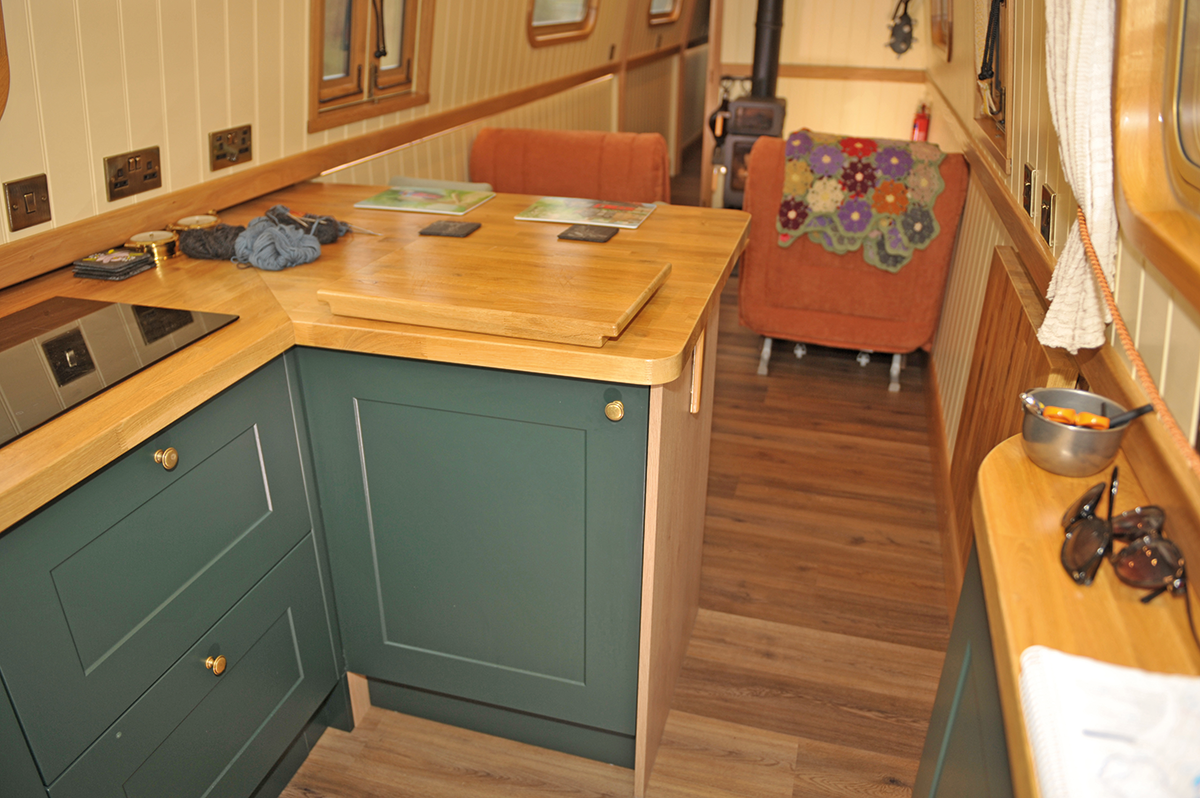
SALOON
The main interest in the saloon is the solid fuel stove, by Ekol. It’s called the Baked Apple Pie, and has been designed especially for small spaces. It has its own stand, and has an oven on top, complete with a pizza shelf. If you want them, you can also get a stainless cooktop and pan supports each side. It’s one of a small number of stoves of this size which conform to the latest Defra standards. For environmental reasons, Hawley burns only wood or wooden heat logs, not coal, and has been pleased by the stove’s performance.
The only other furniture is a couple of large armchairs. As they’re freestanding, they can either be put together down one side of the boat to form a sofa, or in the winter they can be put either side of the boat, so both get the benefit of the stove. They also convert into single beds.
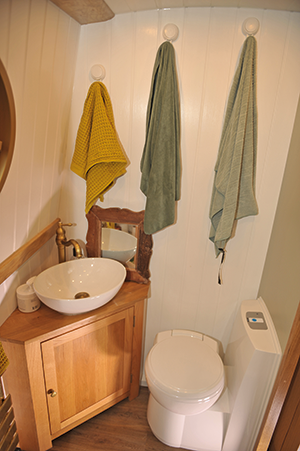 SHOWER ROOM
SHOWER ROOM
This is an off-corridor shower room, with a sliding door on an impressive blacksmith-inspired runner. The shower cubicle is a large rectangle, and has a bi-fold door for ease of access. It’s lined with laminate, which on the back wall has a design which looks like tiles. Alongside there are shelves making use of the space to the hull side and cabin side.
A corner unit provides some storage and carries an oval white basin with an antique brass tap. The towel rail is in gold. The loo is a Thetford cassette, with access to the cassette in the corridor.
The room is light and bright, thanks to the vertical tongue and groove being painted white.
CABIN
Immediately beyond the shower room, and before you reach the cabin proper, is a self-contained wardrobe area. The wardrobes provide plenty of shelf and hanging space for clothes, but it was the space in front that was most important to Hawley. She often boats alone, so she wanted somewhere she could get changed without having to close all the curtains. It also provides a useful passing place if there’s more than one person on board.
The cabin has an inline bed which is 4ft 6in wide, and lifts on gas struts for access to the storage in the base. There’s a padded headboard, and a high level cupboard above the head of the bed. At the other end is a dressing table and the steps up to the bow doors, which have lifting treads for storage.
The bow doors and windows are a uPVC unit. In keeping with the feel of the boat’s interior, the frames have a wood effect finish rather than the more usual white.
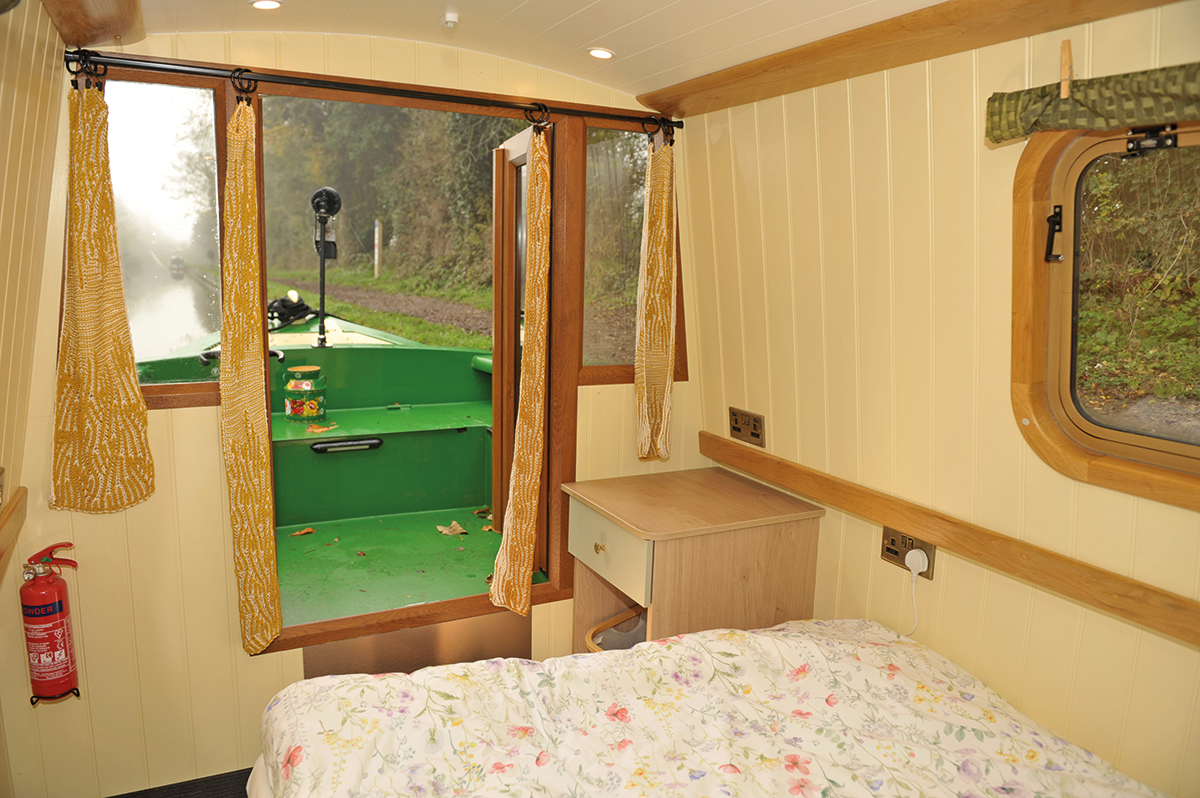
TECHNICAL
Unexpected is a serial hybrid boat, meaning propulsion comes purely from an electric motor, while a generator provides charging for the batteries (when there’s not enough solar). Ortomarine have been specialising in hybrid boats for a while now, and have built a reputation for their expertise in this area. And expertise is needed, because putting together a combination of motor, generator, and batteries that works properly together is not as easy as it might sound.
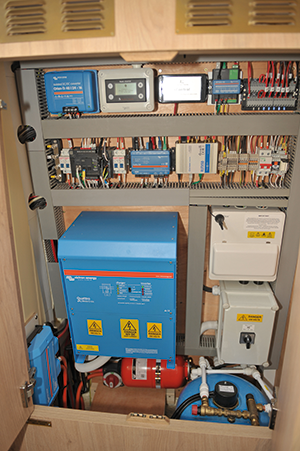 In this case, the motor is a brushless 48-volt unit by Engiro, offering 12kw continuous and 18kw peak output. Also in the engine hole is a Fischer Panda 8000x PVMV-N generator. Rather than normal diesel, it’s running on HVO – Hydrotreated Vegetable Oil. It’s made from certified waste materials and helps reduce CO2 greenhouse gas emissions by up to 90 per cent. The problem is that it’s not widely available on the waterways, so Hawley has had to have refills brought to the boat when necessary. In the summer months, she didn’t run the generator at all, because the 2kw solar array on the roof provided all the energy she needed – even if she occasionally had to wait a day or two for the sunshine. There’s a Victron MPPT controller for the panels, and a Victron 8kva inverter charger to provide a 230-volt supply.
In this case, the motor is a brushless 48-volt unit by Engiro, offering 12kw continuous and 18kw peak output. Also in the engine hole is a Fischer Panda 8000x PVMV-N generator. Rather than normal diesel, it’s running on HVO – Hydrotreated Vegetable Oil. It’s made from certified waste materials and helps reduce CO2 greenhouse gas emissions by up to 90 per cent. The problem is that it’s not widely available on the waterways, so Hawley has had to have refills brought to the boat when necessary. In the summer months, she didn’t run the generator at all, because the 2kw solar array on the roof provided all the energy she needed – even if she occasionally had to wait a day or two for the sunshine. There’s a Victron MPPT controller for the panels, and a Victron 8kva inverter charger to provide a 230-volt supply.
The battery bank is 800Ah at 48volt, consisting of eight 100Ah LiFePo4 batteries by Ritar. Lithium batteries have the advantage of charging very quickly and being able to withstand being discharged to almost nothing. They also don’t mind being left partly discharged. It’s also important to note that these are Lithium Iron Phosphate batteries, which have a different chemistry from the lithium-ions found in phones, computers, and cars, and which have developed something of a reputation for catching fire. The two are not the same.
Ortomarine have their own control system called OrtoMate, which ensures everything works together as it should. The screen at the stern shows you what’s going in and coming out of the batteries and what the solar is producing. It also means you can monitor everything remotely on your smartphone — and you can control things including the generator remotely too.
Speaking of remote control, the electric motor is fitted with the OrtoPilot system, so it can be controlled from the lock side using a handheld weatherproof unit. The bow thruster can be similarly controlled, giving you some left-right movement. This is particularly useful for a single-hander like Hawley.
There is no diesel heating on board. The stove and electric plinth heaters in the galley and cabin suffice.
ON THE WATER
We have tested a lot of electric propulsion boats over the past few years, but this test was the first time we’ve tried one going through a tunnel. It’s an entirely different experience, because of the lack of noise from the engine. It also means that if like Hawley you like to use the acoustics to enhance some music, there’s no engine noise to get in the way. Going through Crick tunnel to the sound of the Peaky Blinders theme will stay with me for a while!
The motor is plenty powerful enough. The tiller is at a nice height, and the Morse control falls easily within reach. The OrtoMate screen is facing the steerer in the mud room – but Hawley prefers to turn it off and take in the surroundings instead. She admits, though, that her progress is often on the slow side.
CONCLUSION
Electric propulsion boats always cost a bit extra. This one came in at around £205,000 – but it had been on the order books for a while. Ortomarine boats start at around £225,000 now.
This is a remarkably well thought out boat, with lots of design flair. The layout and the finishing touches are all a bit different from the norm, but there are good reasons for everything.
It proves that if you give the right amount of consideration to things that are a bit out of the ordinary, they can work. Unexpected works on every level.
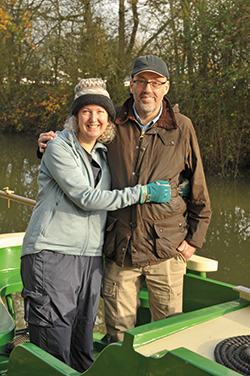 THE OWNERS
THE OWNERS
Hawley Montgomery-Downs lives in West Virginia in the US, but originally comes from California. She’s a professor of neuroscience, working on sleep and sleep disorders. A few years ago, she applied for several university jobs in the UK, and each location seemed to be near a canal. She walked the towpaths and watched the boats, but it was a while before she realised people holidayed and lived on them. Almost immediately, she booked her first hire boat, a weekend from Sowerby Bridge to Skipton.
When she wasn’t boating herself she became a gongoozler, helping people at locks and generally just falling for the canals. She met Ortomarine at the Crick Boat Show, and ordered her boat. The build took place entirely remotely, so it’s something of a miracle that all her ideas were so successfully translated into reality.
Hawley is also introducing her three grown up children into the ways of the canals, and on our visit had her partner, Scott Conrad with her.
Specification
Length: 56ft
Beam: 6ft 10in
Shell: Tim Tyler www.timtylerboats.com
Style: Semi-cruiser
Berths: 2+2+1+1
Fit-out: Painted MDF and oak
Electric motor: Engiro 48VDC 08016 www.Engiro.de
Generator: Fischer Panda 8000i PVMN-N www.fischerpanda.co.uk
Inverter: Victron 8kw www.victronenergy.co.uk
Galley units: Howden’s green www.howdens.com £poa
Microwave: Kaiser Empire black www.kaiser.co.uk £299
Stove: Ekol Apple Pie www.defrastoves.com £1,299
CONTACT
Ortomarine
Unit 4A, Dursley Distribution Park,
Curbs low Lane
Shenstone,
Worcestershire, DY10 4DX
01299 489424
Info@ortomarine.co.uk
www.ortomarine.co.uk
£205,000
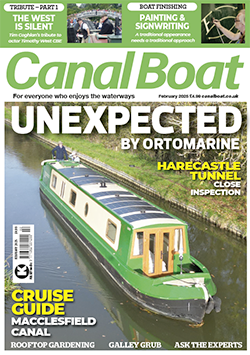 As featured in the February 2025 issue of Canal Boat. Buy the issue here
As featured in the February 2025 issue of Canal Boat. Buy the issue here

